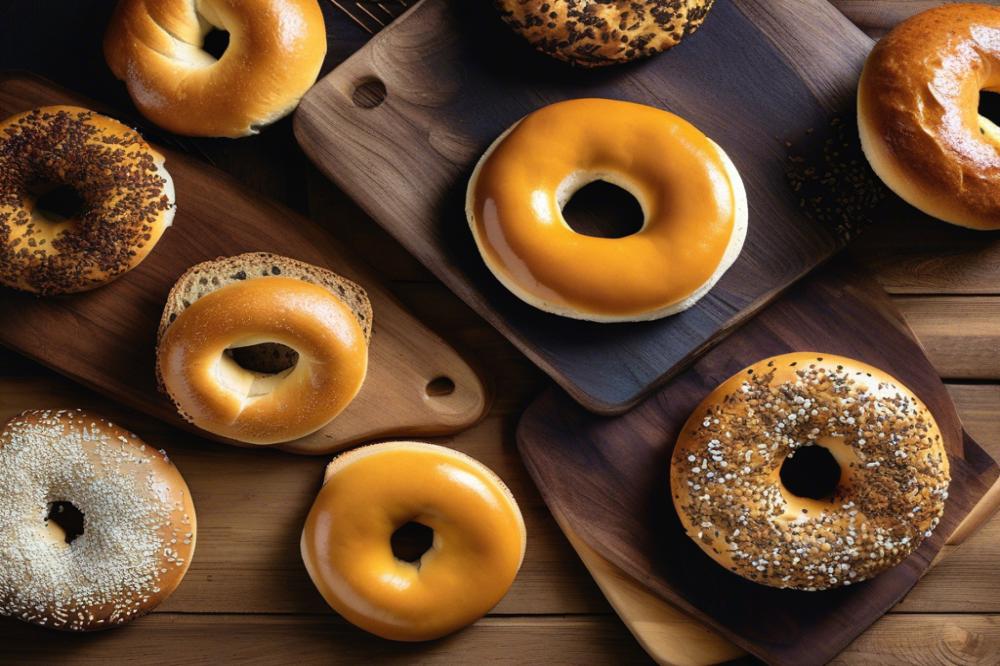Introduction
For many people, a gluten-free diet is not just a trend; it’s a necessity. Conditions like celiac disease and gluten intolerance have made healthy eating a challenge for those affected. As a result, more individuals are seeking delicious alternatives to traditional foods that contain gluten.
Bagels, a beloved breakfast staple for decades, have a special place in the hearts of many. Their chewy texture and rich flavor are hard to forget. Unfortunately, for people avoiding gluten, enjoying this treat has often felt impossible. Bagel shops typically don’t offer gluten-free options, which has further fueled the search for bagel alternatives that satisfy both taste and texture.
This article will explore the best flavor“>gluten-free bagels available on the market. We’ll dive into their flavor profiles and examine various baking techniques used to create them. Additionally, some gluten-free recipes for homemade bagels will be shared, allowing readers to experiment with new ideas in their kitchen. A taste test of popular gluten-free options will help highlight their strengths and weaknesses in comparison to classic bagels.
By the end, you’ll have a clear idea of whether these gluten-free versions can truly match the chewiness and flavor people crave in traditional bagels.
Understanding gluten-free bagels

What exactly are gluten-free bagels? They are baked goods made without wheat or any gluten-containing ingredients. While traditional bagels rely on wheat flour for their structure and chewiness, gluten-free versions use a different approach. The goal remains the same: to create a delicious breakfast option that fits into a gluten-free diet.
Common Ingredients Used in Gluten-Free Recipes
Many gluten-free recipes incorporate a blend of flours. Popular choices include almond flour, rice flour, and tapioca starch. These alternatives often act in harmony to mimic the texture provided by gluten. Some recipes may also feature xanthan gum for added elasticity. Many bakers experiment with different ingredients to find the best gluten-free bagels that maintain flavor and texture.
Differences Between Traditional and Gluten-Free Bagels
When comparing traditional and gluten-free bagels, the results can vary significantly. Traditional recipes yield a chewy texture, thanks to gluten’s unique properties. Bagel alternatives may not achieve that same level of chewiness. However, this doesn’t mean they lack taste. In taste tests, some gluten-free bagels impress with rich flavor profiles and satisfying crunch. Baking techniques differ too. Many people find that boiling gluten-free dough before baking enhances the final product, just as with classic methods.
Gluten-free bagels can offer a healthy eating option without sacrificing enjoyment. Homemade bagels allow for creative freedom, making it easy to explore various flavors. For those seeking gluten-free options outside their kitchens, bagel shops now often feature a range of choices. Understanding these differences can guide you in finding or making the right bagel that fits your dietary needs.
Evaluating Taste and Texture

Classic chewy bagels are famous for their dense and robust texture. Bakers often boil the dough before baking, which gives them a shiny exterior and a satisfying chew. This method also helps the bagels develop their rich flavor. A perfect bagel strikes a balance between outer crust and inner softness. Many people consider this chewy quality essential to the bagel experience.
What about bagel alternatives, specifically the best gluten-free bagels? These often aim to replicate the classic qualities. However, achieving that signature chewiness and flavor can be challenging. Dough made without gluten may not react the same way as traditional dough. Some brands have surfaced, claiming to bridge the gap through innovative gluten-free recipes.
A recent taste test revealed a diverse range of results from different brands. Some gluten-free bagels managed to surprise testers with their flavor. Others fell short, lacking the desirable characteristics of chewy bagels. For example, one brand stood out due to its nutty undertones and moist texture. In contrast, several others were criticized for being overly dry and crumbly.
Factors influencing flavor in gluten-free bagels are varied. Ingredients play a key role. Popular choices include almond flour, tapioca starch, and even chickpea flour. These components contribute to the overall taste and texture. Additionally, specialized baking techniques can enhance the quality of homemade bagels. The right combination might elevate the experience beyond expectations.
Many people are turning to innovative bagel shops that offer gluten-free options. These establishments often experiment with unique flavors and toppings, attracting a broader audience. It appears that healthy eating trends are also influencing the bagel market. As consumers become more adventurous, they are willing to explore what gluten-free options can deliver.
Baking Techniques for Gluten-Free Bagels
Key Techniques for Achieving Chewiness
Making bagels chewy without gluten can be a challenge. However, certain techniques can help replicate that classic texture. Boiling the bagels before baking is a crucial step. This process creates a chewy crust that mimics traditional bagels. Experimenting with different boiling times can also affect the final chewiness.
Importance of Hydration and Dough Handling
Hydration levels in the dough play a significant role in the overall outcome. A wetter dough often leads to a softer, more pliable consistency. Proper handling is equally important. Avoid over-kneading, as this can lead to a tough product. Instead, gently mix ingredients until combined.
Use of Unique Gluten-Free Flours and Additives
Various gluten-free flours can be used to enhance flavor and texture. Almond flour, tapioca flour, and brown rice flour are popular choices. They provide different tastes and moisture levels. Adding xanthan gum or psyllium husk can further improve structure and elasticity. These additives help to bind the ingredients, closely resembling the traditional bagel experience.
Popular Homemade Bagels Recipes
Searching for gluten-free recipes can be overwhelming. Start with simple options that require minimal ingredients. Many recipes include a blend of gluten-free flours and basic pantry items. A taste test amongst friends can reveal which recipes create the best gluten-free bagels. Some individuals even combine their dough with herbs or seeds for added flavor. Others might explore bagel alternatives, which can offer a delightful twist. Crafting homemade bagels allows for creativity and healthy eating choices. Whether from bagel shops or your kitchen, experimentation is key to finding the perfect recipe.
Bagel Alternatives for Gluten-Free Diets
Many people on a gluten-free diet search for tasty substitutes that can match the satisfaction of traditional bagels. Fortunately, a variety of baked goods serve as excellent choices. Options such as gluten-free breads, muffins, and flatbreads offer distinctive flavors that can please the palate.
In comparing these alternatives, flavor and texture play crucial roles. While gluten-free bagels strive to mimic the chewiness of their classic counterparts, items like almond flour muffins provide a moist and rich experience. Sourdough bread made without gluten can surprise many with its tangy taste and chewy crust. It’s important to taste test different products to find what you enjoy most.
Exploring gluten-free recipes at home opens up another world of possibilities. Homemade bagels using gluten-free flour blends allow you to experiment with baking techniques. Adding toppings like seeds or herbs can enhance both flavor and presentation. People focusing on healthy eating also appreciate knowing what goes into their meals.
When seeking healthy eating tips, consider portion size and ingredients. Even gluten-free options can be packed with sugars or unhealthy fats. Being mindful of the nutritional content ensures you make the best choices. Pairing these alternatives with fresh vegetables or lean proteins can create balanced meals.
Finally, visiting local bagel shops that specialize in gluten-free items can lead to delightful discoveries. Many establishments offer a range of products crafted with care. It’s worth exploring what these shops provide, as they often highlight their unique take on flavor and textures.
Spotlight on Gluten-Free Bagel Shops
Many bagel shops now focus on offering gluten-free options. These establishments take pride in serving up some of the best gluten-free bagels. They cater to those with dietary restrictions while delivering delicious flavors.
Recommended Bagel Shops Specializing in Gluten-Free Options
One notable spot is Bagel Bliss in New York City. This shop has a wide range of flavors, from classic sesame to everything bagels. Their baking techniques incorporate alternative flours, which provide great taste and texture. Another favorite is Rise & Shine Bagels in San Francisco. Customers rave about their fresh bagels made from nut and seed flours. The selection ranges from onion to poppy seed, providing plenty of choices for everyone.
Overview of Products and Flavors Offered
Improving gluten-free recipes has allowed shops to offer mouth-watering options. Customers can find varied bagel alternatives that pack in plenty of flavor. The Blueberry Delight from Bagel Bliss is a standout, perfectly balancing sweetness and chewiness. At Rise & Shine, their Garlic & Herb bagel often steals the show during taste tests.
Customer Reviews and Taste Experiences
Reviews from customers highlight the high-quality ingredients used in these gluten-free offerings. Many are surprised by how close these bagels come to the classic versions. “I can’t believe this is gluten-free!” is a common reaction. One customer explained how the flavor profiles made even homemade bagels pale in comparison. With healthy eating in mind, people appreciate the effort to keep flavors rich and satisfying.
Some patrons have shared their experiences with the texture of gluten-free products. They often note how these bagels hold up well when toasted. The chewy interior mimics the beloved qualities of traditional bagels. A few customers recommend trying them with cream cheese or avocado for a delicious meal. Others love to savor these treats on their own.
Final Thoughts
In our exploration of the best gluten-free bagels, it became clear that they can sometimes reach or even surpass the chewy texture we associate with classic varieties. Many brands have made significant strides in improving their recipes. While the taste might not match exactly, several options come surprisingly close. The variety of ingredients used in gluten-free baking allows for diverse flavors that can surprise even the biggest bagel enthusiasts.
Exploring gluten-free baking can be an adventure for anyone, whether living with a dietary restriction or simply curious about alternative foods. Experimenting with recipes opens the door to new textures and tastes. From almond flour to coconut flour, the ingredients available cater to numerous taste preferences. Baking at home offers a chance to customize and control what goes into your food. By simply substituting ingredients, unique creations can arise.
Healthier eating choices can also come from less reliance on gluten. This shift doesn’t mean sacrificing flavor or enjoyment. People can enjoy satisfying foods without gluten. The trend mirrors a growing awareness of dietary needs, promoting inclusivity at dining tables everywhere. A well-made gluten-free bagel can be delicious and fulfilling. Therefore, food lovers should remain open-minded about gluten-free options and give them a try.



